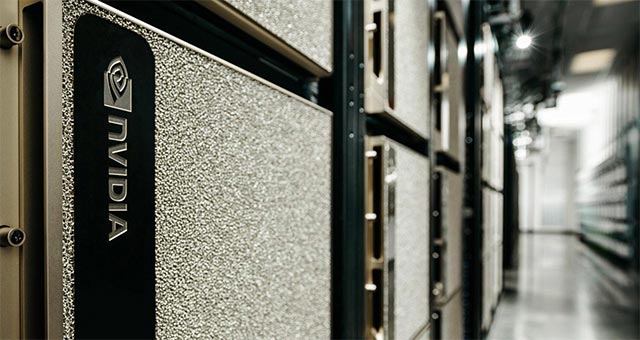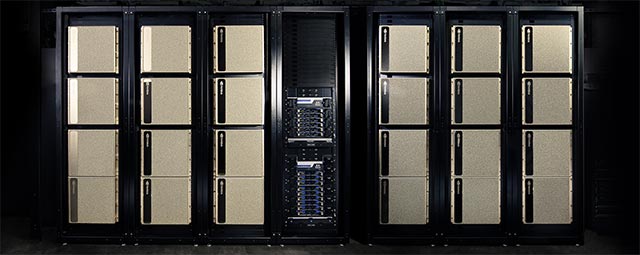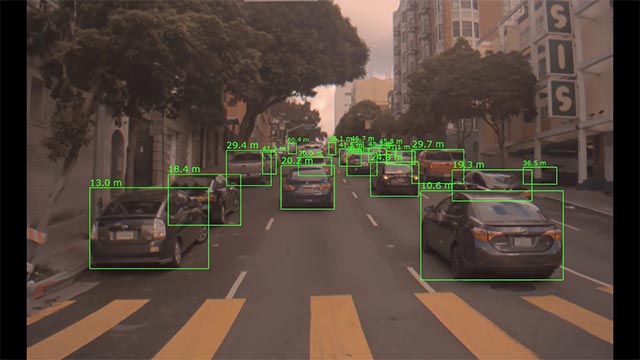Nvidia only takes 3 weeks to create one of the world's strongest AI supercomputers
Self-propelled vehicle technology has achieved remarkable progress in the last few years, but they are still not perfect. There are still many unfortunate accidents caused by autonomous car computer systems.
However, not so that we deny the efforts of car manufacturers, artificial intelligence development companies to create safer self-driving cars, and among them can not Not to mention Nvidia's contribution.
To help the cars become smarter, better handle all possible situations while participating in traffic, Nvidia has just successfully built DGX SuperPod, a dark supercomputer. Optimizing with artificial intelligence, can help design a more complete self-propelled vehicle.
- AMD and Cray will build the world's fastest supercomputer for the US government
 DGX SuperPod is powerful enough to cope with the most difficult tasks
DGX SuperPod is powerful enough to cope with the most difficult tasks
Nvidia has made it very clear that they want to be one of the world's leading companies in artificial intelligence, and decided to build a supercomputer to prove it. The results were astonishing, the US chip maker only took 3 weeks to successfully install a supercomputing complex by connecting 96 Nvidia DGX-2H supercomputers with the advanced Mellanox technology.
Want to own this supercomputing cluster? Of course it is. Nvidia does not make 'supercomputer' supercomputer, this is a method for them to promote themselves - a great form of marketing. And to own this supercomputer system, you have to meet one condition, it's rich!
Making a small calculation, each of the constituent Nvidia DGX-2H supercomputers costs $ 435,000 (more than 10 billion), and DGX SuperPod is a combination of 96 'monsters' worth 435,000 that dollar. Thus, DGX SuperPod will only belong to those who have spent at least 41,760,000 (approximately 960,480,000,000 VND).
- Supercomputers can completely detect cyber threats
Clearly, this supercomputing complex was built to target large corporations, specifically, self-propelled car manufacturers. Spending about $ 41 million for a hardware-assisted development system is not small, but it deserves the value of one of the best hardware systems at the moment.
With 1,536 Nvidia V100 Tensor Core GPUs, DGX SuperPod provides excellent processing power in terms of a relatively small computer system (according to today's supercomputer systems). However, if Nvidia wants large corporations to invest in this expensive supercomputing system, they must prove that it can handle the most complex problems businesses are facing. USD 41.7 million is not a big sum for corporations that are interested in self-propelled vehicles such as Google, Apple, Ford, Toyota or Tesla . but that is not a small amount to waste for an investment. uncertain.
- The most powerful supercomputer today, has 1 million processing cores, equal to 1% of human brain power
 To own DGX SuperPod, you have to spend nearly 42 million USD
To own DGX SuperPod, you have to spend nearly 42 million USD
Nvidia wants DGX SuperPod strong enough to cope with the most difficult tasks. That's why this manufacturer decided to steer DGX SuperPod to support solving one of the most difficult issues in the field of self-propelled vehicle development today: AI.
AI computer systems in self-propelled vehicles require a huge amount of training data compared to technologies that use similar image classification models for a number of other relatively complex purposes ( such as guessing places or prescriptions). The AI in an autonomous vehicle aims to be more specific and specific, and it needs to consider all the surrounding environmental factors, as well as understand these factors well enough for the car to work. safe action. All of these factors generate approximately 1 terabyte of data that needs to be processed for every 1 hour the vehicle is in operation, and the AI system responsible for managing self-propelled vehicles needs to re-train themselves constantly. over time using data from the entire operation.
- AI was able to classify objects on the road by radar
Nvidia has demonstrated how their DGX SuperPod supercomputer can help speed up the processing of training data measured in petabytes as follows:
"This system is capable of stable operation at high performance levels 24/7, optimizing automatic driving software and retraining neural networks at much faster turnaround times than before. For example, the DGX SuperPod hardware and software platform only takes less than 2 minutes to complete the ResNet-50 model training, while at the time this AI model appeared in 2015, it took 25 people. days to train it through one of the most advanced computer systems - single Nvidia K80 GPU So DGX SuperPOD delivers 18,000 times faster results while other TOP500 systems have similar performance levels. Self-built from thousands of servers, occupying a space and huge power consumption, DGX SuperPOD only accounts for a fraction modest time, about 400 times smaller than the computer systems with similar power or more insignificant at the moment ".
- Is humanity on the right track in developing self-propelled vehicle technology?
 DGX SuperPod has impressive power but is considerably smaller in size than other supercomputers
DGX SuperPod has impressive power but is considerably smaller in size than other supercomputers
Although DGX-2H works best when using ResNet-50, those numbers will still be impressive when scaled to any image classification AI model. The impressive performance from a multi-million dollar supercomputer system is imperative, but delivering such impressive performance in a small (relative) size is a huge plus, that is Clear evidence for the question why Nvidia has, is, and will remain one of the manufacturers that dominate the AI hardware market.
Such hardware progress will bring about specific benefits in the development of self-propelled vehicles?
Nvidia believes that supercomputers such as DGX SuperPOD will support creative AI to create new and more accurate ways of calculating distances between objects in three-dimensional space through which self-propelled vehicles can easily predict and prevent possible collision situations.
Nvidia explains some of the key areas where this new approach improves safety as follows:
"We use convolutional neural networks and data obtained from a front camera system. DNN is trained to predict the distance from the vehicle to objects using radar sensor data and lidar. As a form of practical information, engineers know this information is accurate because the direct reflection of radar and lidar signals can accurately indicate the distance to the object, regardless of the road link structure. how".
- What will be the impact of self-propelled vehicle technology on the transportation platform?
 Determine the distance to the object - the most important task that the car AI must undertake
Determine the distance to the object - the most important task that the car AI must undertake
"By training neural networks with radar data and lidar data instead of relying on flat ground assumptions, we help DNN estimate the distance to objects from a camera, even when the car going up or down a ramp ".
It seems that Nvidia is holding some new advances in artificial intelligence on an almost weekly basis. This is because they successfully built one of the world's most powerful supercomputers in just 3 weeks. When you don't have to wait long to handle a huge amount of data, that means you will be able to quickly test new ideas and find the optimal solution a lot faster than your opponent. It is not difficult for other businesses to do so, just spend nearly 42 million USD!
You should read it
- The DGX-1 supercomputer uses Nvidia's Volta GPU to bring 400 servers into one box
- What is supercomputer used for?
- Computer manufacturing Nvidia can drive automatically
- A series of supercomputers in Europe were suddenly attacked
- Which country owns the most powerful supercomputers today?
- AI classifies objects on the road only by radar measurements
- Will NASA partner with Tesla to create the most unprecedented lunar exploration vehicle?
- China surpassed the US in the supercomputer race
May be interested
- Ni no Kuni: Cross Worlds - How to turn off auto-battle and auto-play
 ni no kuni: cross worlds is a comprehensive multiplayer role-playing game from developer level-5, with cutscenes made by studio ghibli, the renowned animation studio that has made iconic films such as my neighbor totoro and spirited away.
ni no kuni: cross worlds is a comprehensive multiplayer role-playing game from developer level-5, with cutscenes made by studio ghibli, the renowned animation studio that has made iconic films such as my neighbor totoro and spirited away. - Review : The Outer Worlds - Peril On Gorgon DLC- Your choices make you who you are
 once again experience the sci-fi life through the outer worlds - peril on gorgon dlc after an 11-month absence.
once again experience the sci-fi life through the outer worlds - peril on gorgon dlc after an 11-month absence. - Disable the NVIDIA component to speed up the computer
 nvidia graphics card is one of the devices supporting the best graphic design field work today. however, not everyone knows it is also a factor slowing down the computer by installing more components together with package driver installation.
nvidia graphics card is one of the devices supporting the best graphic design field work today. however, not everyone knows it is also a factor slowing down the computer by installing more components together with package driver installation. - TOP 10 supercomputers with fastest processing speed in the world
 help you better understand supercomputers, introduce top 10 fastest supercomputers in the world with information about the country of ownership, processing speed and top performance.
help you better understand supercomputers, introduce top 10 fastest supercomputers in the world with information about the country of ownership, processing speed and top performance. - The fastest supercomputers in the world
 today we will talk about supercomputers, taking a look at the top 10 fastest supercomputers in the world today.
today we will talk about supercomputers, taking a look at the top 10 fastest supercomputers in the world today. - 7 dog breeds with the strongest bite force, extremely dangerous
 what is the dog with the strongest bite? let's check out the top dog breeds with the strongest bite!
what is the dog with the strongest bite? let's check out the top dog breeds with the strongest bite! - Steps to open Nvidia Control Panel
 nvidia's control panel is a utility found on nearly all desktop computers and many laptops with nvidia graphics hardware installed. it can adjust resolution, refresh rate, color settings, and nvidia-specific features like g-sync.
nvidia's control panel is a utility found on nearly all desktop computers and many laptops with nvidia graphics hardware installed. it can adjust resolution, refresh rate, color settings, and nvidia-specific features like g-sync. - Summary of information about Nvidia RTX 50 Series graphics cards
 nvidia makes some of the best graphics cards, but it doesn't rest on its laurels. while the rtx 40 series, which has been bolstered by a refresh, is still very new, nvidia is also working on next-generation gpus from the rtx 50 series.
nvidia makes some of the best graphics cards, but it doesn't rest on its laurels. while the rtx 40 series, which has been bolstered by a refresh, is still very new, nvidia is also working on next-generation gpus from the rtx 50 series. - Nvidia's 7nm process GPU will probably launch in 2020?
 according to reliable sources, nvidia is said to be working closely with one of the world's largest semiconductor chip makers, samsung, in preparation for a strategic line of rtx graphics cards.
according to reliable sources, nvidia is said to be working closely with one of the world's largest semiconductor chip makers, samsung, in preparation for a strategic line of rtx graphics cards. - Nvidia will release a new software solution, replacing Nvidia Control Panel and GeForce Experience
 nvidia's latest announcement is what many of us have been waiting for. the company is releasing a new software solution that it hopes will one day replace nvidia control panel and geforce experience.
nvidia's latest announcement is what many of us have been waiting for. the company is releasing a new software solution that it hopes will one day replace nvidia control panel and geforce experience.










 Samsung's Deepfake could make dark monk Rasputin sing like a real thing
Samsung's Deepfake could make dark monk Rasputin sing like a real thing Nvidia's STEAL AI offers the ability to support inference for better computer vision models
Nvidia's STEAL AI offers the ability to support inference for better computer vision models AI models use aerial and ground data to navigate areas that are difficult to observe
AI models use aerial and ground data to navigate areas that are difficult to observe 5 genius minds in the AI field join hands to create awesome robots
5 genius minds in the AI field join hands to create awesome robots AI classifies objects on the road only by radar measurements
AI classifies objects on the road only by radar measurements The future of AI and people is cooperation
The future of AI and people is cooperation